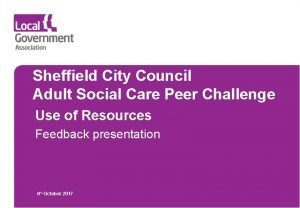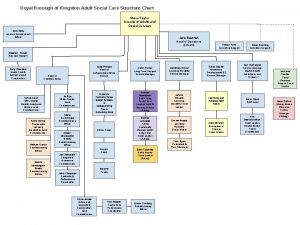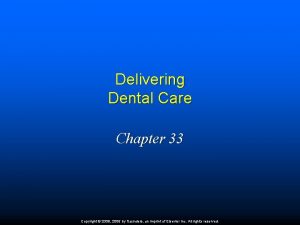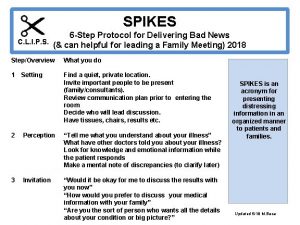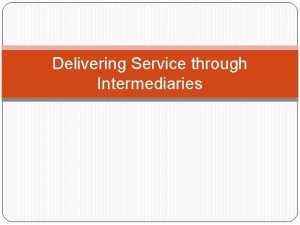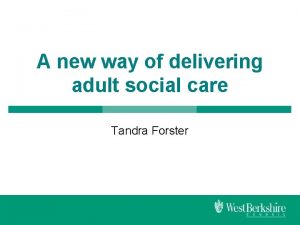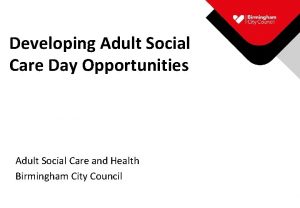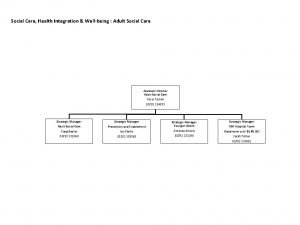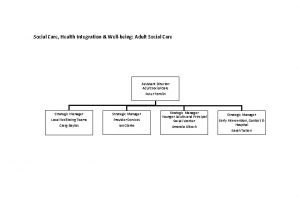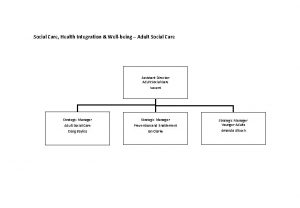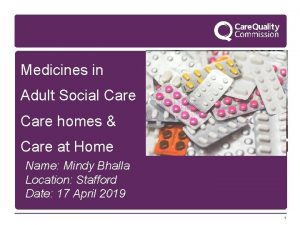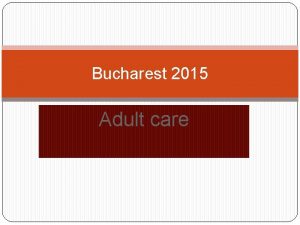A new way of delivering adult social care




















- Slides: 20

A new way of delivering adult social care Tandra Forster

The headlines

Challenges q Austerity q Ageing population q Burden of disease q Integration q Care Act

Key drivers of change

Pressures! ‘Fiscal austerity’ is now expected to extend to at least 2018

‘If I had asked people what they wanted, they would have said a faster horse’ Henry Ford

2. A new way of delivering adult social care

Two Choices: n Centralisation, making it harder, savings targets. ¨or n Stop assessing people for services, focus on what they really want, focus on strengths not deficits, carers, social work as investment advisors.

One Model: Help To Help Yourself Accessible, friendly, quick, information, advice, advocacy, universal services to the whole community, prevention Safeguarding Immediate short term help, reablement, intensive support to regain independence, minimal delays, no presumption about long-term support, goal focussed, integrated. On-Going Support for Those who Need it Self directed, personal budget based, choice and control, highly individualised Right Skills, Right People Help When You Need It

Golden Rules Always offer tiers 1 and 2 before offering tier 3. n Never plan long term with people in crisis – stick to people like glue. Always think hard about what will help carers continue caring. n In tier three – we’re not experts, but ‘investment advisors. ’ n 100% of people and families plan their own support. n Learn as we go using data we trust. n Benchmark – is the response good enough if it was you, or someone you love? n

4. Bubbles of innovation

Bubbles n n n n Co-produce a precise set of rules about doing things differently. Let the world carry on. Be really clear about what you are going to do – and for how long. Go with the grain – where there is the greatest likelihood of success. Know how you are going to collect data – everyday – from day one. Make everything transparent and visible. Learn as you go – weekly meetings. Work to a plan – stop – reflect and learn. Go again.

First Phase Two innovation bubbles q 5 th January start, reviewing initial results but so far very positive q n n n First Contact – focus on people new to the Council Ongoing needs – people already in receipt of services All 3 conversations Stick to people like glue ¨ No hand offs until the right time ¨ n n Second phase – scaling up Second evaluation – August 15

Joint Care Provider – Tier 2 conversation q You know what I want! q I know what I want! q Does it matter who pays for it?

The task: To simplify the route to independence q Develop a shared understanding with every ‘Sam’, and do it quickly! q Challenge our own bureaucracy q Target the right experts q Pool resources

Who wins? q ‘Sam’ gets home and gets on with his life. q Hospital beds freed more quickly. q Costs for long term care do not escalate through the disorienting and de-skilling effects of excessive stays in hospital. q Less duplication = improved capacity

What makes the change hard? q Comfort of current working methods. q Conversion of managers into Change Managers. q Pressure to maintain high performance levels during change.

How we are achieving change: q Step changes closely monitored to allow adjustment and refinement learning from the effects of first steps. q Testing new route on Hospital Discharge patients first, and then extending to all. q Seeking ‘licence’ from the Partner organisations to test new permissions.

Development Framework for: q 7 Day working – testing all pathway steps for ability to match ‘Sam’s needs, and to respond to and match other system activity. q Trusted assessors – allowing partner staff to commission across organisations. q Generic Care Worker – developing/testing role with BHFT Therapy assistants and WBC Care Workers.

Any Questions ?
 Stit sheffield
Stit sheffield Adult social care kingston
Adult social care kingston Chapter 33 delivering dental care
Chapter 33 delivering dental care Conventional software
Conventional software Primary care secondary care tertiary care
Primary care secondary care tertiary care Health and social care values unit 2
Health and social care values unit 2 Apa itu social thinking
Apa itu social thinking Social thinking social influence social relations
Social thinking social influence social relations How to do a two way frequency table
How to do a two way frequency table Two way anova
Two way anova Explain about threaded binary tree
Explain about threaded binary tree Perbedaan one way two way anova
Perbedaan one way two way anova One way two way anova
One way two way anova One way anova vs two way anova
One way anova vs two way anova Analisis two way anova
Analisis two way anova This way that way over the irish sea
This way that way over the irish sea Talk this way
Talk this way Bad news
Bad news Christ delivering the keys of the kingdom to saint peter
Christ delivering the keys of the kingdom to saint peter -is not one of the purposes for giving oral presentations.
-is not one of the purposes for giving oral presentations. Delivering services through intermediaries
Delivering services through intermediaries
